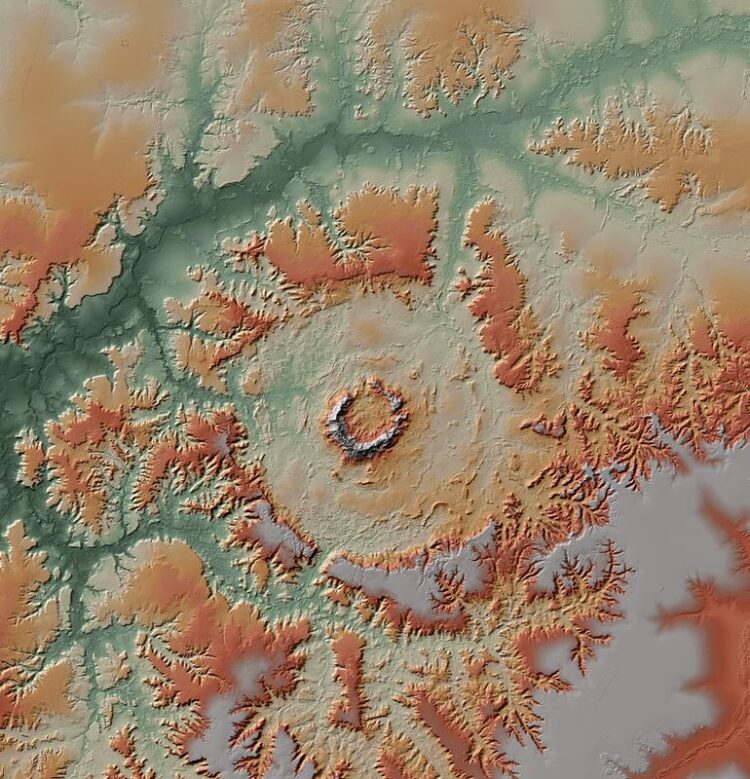The craters on Earth

Physical map of the Serra da Cangalha, Brazil, impact structure, produced using the TanDEM-X mission digital elevation model.
Illustration: Gottwald, Kenkmann, Reimold: Terrestrial Impact Structures, The TanDEM-X Atlas, Verlag Dr. Friedrich Pfeil
A two-volume atlas presents and explains the impact sites of meteorites and asteroids worldwide
Prof. Dr. Thomas Kenkmann, geologist from the University of Freiburg’s Institute of Earth and Environmental Sciences, together with mineralogist Prof. Dr. Wolf Uwe Reimold from the University of Brasilia, Brazil, and Dr. Manfred Gottwald from the German Aerospace Center (DLR) published an atlas providing a comprehensive overview of all known impact craters on every continent. The authors present the more than 200 terrestrial impact sites in high-resolution topographic maps and satellite images, complete with detailed geological descriptions and photographs of the crater structures and their rocks. They also explain the essential details of each impact event.
The formation of craters by asteroid and comet impact has always been a fundamental process in the solar system, explains Kenkmann. As the planets developed along with their moons, these impacts played an important part in accreting planetary mass, shaping the surfaces of planetary bodies, and later also influencing their development. And larger meteorite impacts eventually affected the development of life on Earth.
Today, mapping of what can still be seen of the impact structures on the Earth’s surface can be done by satellites in low Earth orbit. From 2010 to 2016, the DLR successfully measured the Earth’s surface with the radar satellites of the TanDEM-X mission. The acquired data allowed, for the first time, to derive a worldwide terrain model with a height accuracy of up to one meter. From this global digital elevation model the authors have been able to produce this complete topographic atlas of 600 pages with information about all terrestrial impact craters known to date.
Original publication:
Gottwald, M., Kenkmann, T., Reimold, W. U. (2020): Terrestrial Impact Structures. The TanDEM-X Atlas. Part 1 and 2. Munich.
Contact:
Prof. Dr. Thomas Kenkmann
Institute of Earth and Environmental Sciences
University of Freiburg
Tel.: +49 761 203 6495
thomas.kenkmann@geologie.uni-freiburg.de
Originalpublikation:
https://www.pr.uni-freiburg.de/pm-en/press-releases-2020/the-craters-on-earth?se…
Media Contact
All latest news from the category: Earth Sciences
Earth Sciences (also referred to as Geosciences), which deals with basic issues surrounding our planet, plays a vital role in the area of energy and raw materials supply.
Earth Sciences comprises subjects such as geology, geography, geological informatics, paleontology, mineralogy, petrography, crystallography, geophysics, geodesy, glaciology, cartography, photogrammetry, meteorology and seismology, early-warning systems, earthquake research and polar research.
Newest articles

NASA: Mystery of life’s handedness deepens
The mystery of why life uses molecules with specific orientations has deepened with a NASA-funded discovery that RNA — a key molecule thought to have potentially held the instructions for…

What are the effects of historic lithium mining on water quality?
Study reveals low levels of common contaminants but high levels of other elements in waters associated with an abandoned lithium mine. Lithium ore and mining waste from a historic lithium…

Quantum-inspired design boosts efficiency of heat-to-electricity conversion
Rice engineers take unconventional route to improving thermophotovoltaic systems. Researchers at Rice University have found a new way to improve a key element of thermophotovoltaic (TPV) systems, which convert heat…



